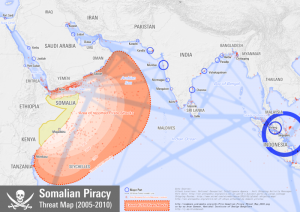Countering Piracy At Sea: Use Of Force A Solution? – Analysis
By RSIS
The use of military means to free hijacked ships in the Gulf of Aden off the Somalia coast, though successful, has resulted in retaliative action. A comprehensive approach is required to deal with the piracy problem.
By Jane Chan
MILITARY ACTIONS against piracy in the Gulf of Aden in the first half of 2011 saw the successful release of hijacked vessels, with pirates arrested, wounded, or in some instances, killed. Media commentators have lauded the actions of the Indonesian military in securing the release of the hijacked MV Sinar Kudus. Earlier, the Republic of Korea Navy (ROKN) secured the release of MV Samho Jewelry, killing eight pirates and capturing another five. Such successes coupled with increasing domestic pressure and from the shipping industry have led to a greater willingness by some navies to use force to free hijacked ships.
Inherent Risk
However, there have been collateral damages. The master of MV Samho Jewelry was shot in the process of rescue. This episode recalls a prior incident where a French yacht’s skipper was killed during a military raid by the French Special Forces. The killing of the four American hostages on board SV Quest by Somali pirates had commentators questioning the use of force once the pirates had taken the crew hostage.
Indeed there are inherent risks involved in military interventions, not least to the hostages and the boarding parties. Such rescue missions would require boarding in hazardous and sometimes extreme conditions, with a need to operate and discharge firearms in the confines of a vessel.
Some navies have recognised the risk of using force in hostage situations. The European Union Naval Force Somalia (EU NAVFOR) maintains that it would not resort to the use of force should such actions endanger the safety of the hostages. This policy is reflected in the rules of engagement (ROE) of other navies operating off Somalia as well.

Notwithstanding the success of previous military rescue operations there is a real risk of reprisals by pirates. Case in point, when Somali pirates freed the MV Asphalt Venture after the payment of ransom, they continued to hold hostage the seven Indian crew on board. This led to the Indian government’s decision to stop arresting pirates and bringing them home for prosecution, ostensibly to avoid further reprisal actions.
More recently, pirates refused to release South Korean seafarers on MV Gemini, demanding the release of those captured by the South Korean authorities, as well as compensation for the death of eight others during the Samho Jewelry incident. In this case, the use of force has caused resentment, providing an excuse for tit-for-tat actions. In a worst case scenario, this may evolve into more aggressive use of force by the pirates, exposing vessels and crews operating in those waters to greater risk.
Temporary respite
While military intervention can help deter piracy, it offers at best a temporary respite. Strong calls from the international shipping community for states to act often assume that navies have absolute and unchallenged authority in deciding how to best deal with the task at hand. The decision to use force needs to be a reasonable and balanced one. It must be conducted in accordance with the rule of law. Considerations would necessarily include the capabilities and intentions of the pirates, the vulnerability of the ship’s crew and potential collateral damages should force be employed. Granted, exigencies of situations will require exceptional action, but such actions must remain that – an exception.
Ultimately, the problem lies within the weak regime in Somalia which has tenuous control over its maritime domain. The problem at sea is a consequence of the social-political problems in the country. As many analysts have rightfully pointed out the fight remains on land. That includes the need to address the governance issues, to provide economic opportunities to the unemployed, to establish an effective legal system, and to build an effective local defence and security enforcement agencies.
Calculated Solution
The discourse on counter-piracy effort tends to see blunt solutions, including increased force. However the real solutions have proven to be complicated and challenging, as they cut across various dimensions of security conditions involving different stakeholders. Operations not involving the use of force have also garnered considerable success.
The Combined Task Force (CTF 151) and EU NAVFOR had on various occasions managed to identify and intercept suspected pirate skiffs, thwarting potential attacks. These successes all share the same trait – early detection – through patrol and reconnaissance activities by the maritime forces, though more often as a result of early reporting by the targeted vessel. It is vital that all ships comply with the Best Management Practice (BMP) guidelines as its first line of defence, but many vessels are still not doing so. There have also been cases where Somali pirates have released vessels after peaceful negotiation with the ship owners. Though not ideal, this approach has avoided the use of force.
The key point is that there needs to be a comprehensive approach involving a concerted effort from all stakeholders for effective alleviation and eventual curtailment of the problem – both on land and at sea. In the meantime, it is necessary to take steps to first reduce opportunities for pirates as well as vulnerabilities of the international shipping community in these waters, including ensuring that all ships in piracy-prone areas comply with the BMP. Increased use of force is far from being a complete solution.
Jane Chan is a Research Fellow at the S. Rajaratnam School of International Studies (RSIS), Nanyang Technological University. She is also Coordinator of the Maritime Security Programme, Institute of Defence and Strategic Studies at RSIS.
